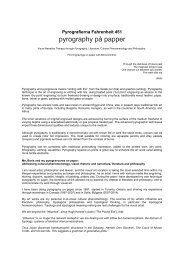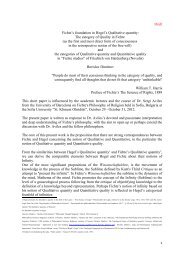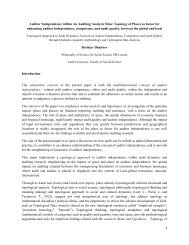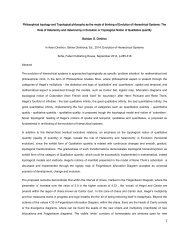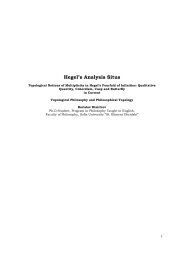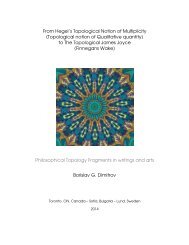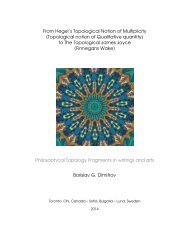Topological Ontology and Logic of Qualitative quantity
Qualitative quantity and BFO (Basic Formal Ontology) of /Barry Smith/ and YAMATO (Yet Another More Advanced Top-level Ontology) of /Riichiro Mizoguchi/
Qualitative quantity and BFO (Basic Formal Ontology) of /Barry Smith/ and YAMATO (Yet Another More Advanced Top-level Ontology) of /Riichiro Mizoguchi/
- No tags were found...
You also want an ePaper? Increase the reach of your titles
YUMPU automatically turns print PDFs into web optimized ePapers that Google loves.
<strong>of</strong> Leonard Euler <strong>and</strong> later with the works <strong>of</strong> Henri Poincare, springs the fluid <strong>of</strong> one<br />
postmodern science, the science <strong>of</strong> topology.<br />
Topology challenged <strong>and</strong> changed the conditions <strong>and</strong> the grounds <strong>of</strong> “hard” sciences by<br />
redefining the means <strong>of</strong> construct, suggesting that intrinsic properties were no longer<br />
sufficient to describe a figure. In topology geometrical figures like circle, triangle <strong>and</strong><br />
square are the same.<br />
This character <strong>and</strong> role <strong>of</strong> “Analysis situs” is the reason to define topology as postmodern<br />
science. The last development <strong>of</strong> topology <strong>and</strong> its applications has proved her role to make<br />
meaningful, qualitative statements <strong>and</strong> analysis not only to the mathematical objects but<br />
also to the cultural <strong>and</strong> social dynamics.<br />
Social Topology <strong>and</strong> Philosophical Topologies are the fruits <strong>of</strong> this postmodern mathematics.<br />
Topology stems from the need to overcome the traditional, “solid” division <strong>of</strong> knowledge,<br />
typical <strong>of</strong> Western culture, which goes back to the contrast between philosophy seen as<br />
episteme (Plato, Aristotle), <strong>and</strong> philosophy seen as rethoric (Isocrates), right to the Hegelean<br />
<strong>and</strong> later Diltheyan distinction between the sciences <strong>of</strong> nature <strong>and</strong> those <strong>of</strong> the spirit.<br />
The phenomenom <strong>of</strong> underst<strong>and</strong>ing is the domain <strong>of</strong> hermeneutics. In the sense <strong>of</strong> Bauman,<br />
Sociological Hermeneutics is about the underst<strong>and</strong>ing <strong>and</strong> interpretation <strong>of</strong> sociality in the<br />
liquid times <strong>and</strong> places as toposes <strong>of</strong> Liquid modernity. Bauman’s model <strong>of</strong> Liquid Modernity<br />
<strong>and</strong> his sociological hermeneutics could be integrated with the tools <strong>of</strong> topology <strong>and</strong><br />
topological approach to cultrual dynamics <strong>and</strong> social underst<strong>and</strong>ing.<br />
Urgen Klüver <strong>and</strong> Christina Klüver with their book “Social Underst<strong>and</strong>ing: On<br />
Hermeneutics, Geometrical Models <strong>and</strong> Artificial Intelligence” (2010) proposed an analysis<br />
<strong>of</strong> hermeneutical problems by mathematical models (in what they defined as Hermeneutical<br />
AI, something more than metaphor) aiming to bridge the gulf between the science <strong>and</strong> the<br />
humanities. According to Klüver <strong>and</strong> Klüver, topology is the most influetial factor to the<br />
dynamical beheviour <strong>of</strong> the complex system. (p.120)<br />
The topological approach to social science could be traced back to Kurt Lewin’s study<br />
“Principles <strong>of</strong> <strong>Topological</strong> Psychology” (1936) <strong>and</strong> followed trough the era <strong>of</strong><br />
postmodernity in the works <strong>of</strong> philosophical topologies (Arkady Plotinsky). In sociology, the<br />
so called topological sociology or social topology was developed by Gregory Bateson, <strong>and</strong><br />
also evident in works <strong>of</strong> anthropology Levi-Strauss <strong>and</strong> Edmund Leach.<br />
John Law <strong>and</strong> Annemarie Mol’s study “Regions, Networks <strong>and</strong> Fluids: Anaemia <strong>and</strong> Social<br />
Topology” (2010) discusses the opportunity to add to the well known types <strong>of</strong> social space<br />
or topological forms <strong>of</strong> spatiality – “regions” <strong>and</strong> “networks”, mobilized in social theory, the<br />
third kind or form <strong>of</strong> social space called “fluid spatiality”.<br />
Law <strong>and</strong> Mol establishes that “sometimes social space behaves like a fluid…<strong>and</strong> flow...the<br />
space with which we are dealing is fluid.”<br />
Bauman himself underlined the network characteristic <strong>of</strong> sociality.<br />
Spatial or <strong>Topological</strong> thinking <strong>of</strong> Modernity – Fluid Modernity – presupposes the concept<br />
<strong>of</strong> Relational Space. The relational thinking about space <strong>and</strong> time originated with Leibnitz’s<br />
works in the non-Eucledean geometry. Space is always in a process <strong>of</strong> becoming. Space<br />
could be seen as a verb, rather than a noun. Space is doing. Space is practiced, space is<br />
experiencing. Verb-a-tizing time <strong>and</strong> space is timing <strong>and</strong> spacing.<br />
55





